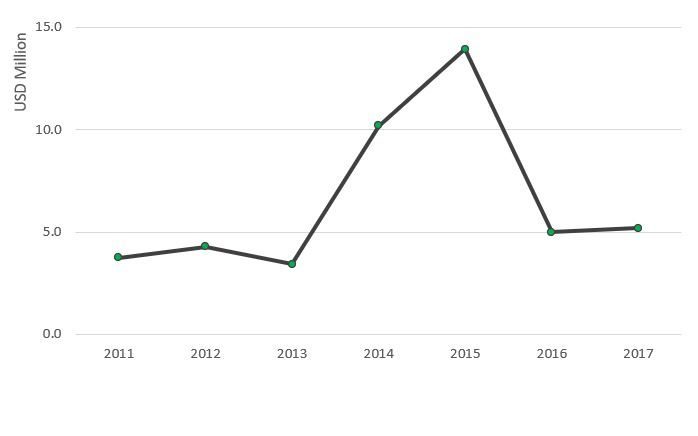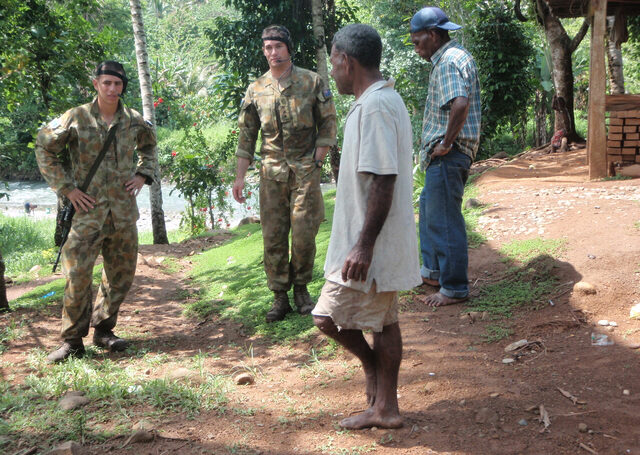Years ago, I hitchhiked from Weipa, down the Cape York Peninsula to Kuranda, in the hills behind Cairns. Beautiful country, but I don’t remember much of it. Mostly I remember discomfort as the Land Rover clattered hectically over serrated dirt road, and jolts of fear as we plunged in and out of dry river beds. When we finally hit smooth tarseal, I was very, very relieved.
As it is with roads in Northern Queensland, so it goes with aid. If you’re a recipient, aid flows are much easier to manage when they are smooth and steady. Aid that bounces up and down can derail fiscal planning, and destabilise everything from government departments to local communities. Good aid arrives at a consistent pace. Increases are okay, as are falls, but they need to occur over a period of years, not overnight.
The technical term for aid flows that bounce around is volatility. In our recent open access Asia & the Pacific Policy Studies article, Imogen Nicholls and I examined aid volatility in the Pacific. (We also looked at fragmentation, but, for the sake of a succinct blog, I will focus on volatility here.)
We had good grounds for taking an interest in aid volatility in the Pacific. It’s the world’s most aid dependent region. And by some measures, the countries of the Pacific also receive some of the world’s most volatile aid.
We based our analysis on the Lowy Institute’s Pacific Aid Map data set, using data on government aid covering 2011 to 2017. Pacific Aid Map data meant we could include newer donors like China in our analysis, as well as OECD Development Assistance Committee (DAC) donors like Australia and New Zealand.
As we studied volatility, we looked at donor-recipient pairs. We studied how volatile aid from a particular donor (New Zealand, for example) was to a particular recipient (Tonga, for example). We did this because pairs of this sort are at the heart of aid giving. If you’re a recipient government (Tonga, to continue our example), and New Zealand’s aid bounces around from year to year, it’s going to be hard to manage, even if some other donors give fairly stable aid. And if you’re a donor, for example New Zealand, while you can’t control what other donors do, you can mend your own ways. We also took care to remove trends of steady change from our measure of volatility. We were interested in rapid, short-term change, not slower change of the sort that can be planned for. Finally, we excluded humanitarian emergency work from our analysis. Emergencies happen in a hurry: it’s understandable that aid responding to such situations will be volatile.
In most of the article we focused on larger donors, both for simplicity’s sake and because they have a larger impact.
Full details of our methods and results are in the article, but here’s the essence of what we found.
Volatility varies a lot between Pacific countries. The figure below shows you this. Palau received the most volatile aid. Solomon Islands received the least volatile.
Volatility of aid from the median donor (in terms of volatility) among the five largest donors to each recipient
We can only provide tentative answers as to why some countries get more volatile aid than others, but it seems possible that being smaller leads to worse volatility. Also, countries receiving aid that is fragmented across many projects are more likely to suffer greater volatility (once population is controlled for). We can’t confidently claim that greater project fragmentation causes more volatile aid, but some Pacific countries are suffering a twin burden: aid that is both too volatile and broken into too many discrete projects. These countries deserve better aid coordination.
We also studied which donors gave the most volatile aid. When we did this, we continued to look at donor recipient pairs and focused mainly on the 15 largest donors in the Pacific. Once again we found variation.
Volatility by donor (to their median Pacific recipient in terms of volatility)
Australia and New Zealand gave the least volatile aid. China, to pick a topical donor, didn’t do as well, but was far from the worst performer. Taiwan gave the most volatile aid, followed by France. We could find no obvious explanations for why some donors gave more volatile aid than others. However, when we ran regressions using all donors to the Pacific, not just the top 15, we did find that, on average, newer non-OECD DAC donors tended to give more volatile aid than their DAC counterparts. If there is a group of countries that needs to work hardest on giving stable aid in the Pacific, it is these newer donors.
The Pacific region receives some of the most volatile aid on earth, but not all countries in the Pacific experience the problem equally. And not all donors are equally to blame. The challenge in coming decades will be for some of the region’s newer donors to start demonstrating a sustained commitment to supporting the Pacific. This will require giving aid well – including managing volatility.
This piece is based on an article in the Asia & the Pacific Policy Studies journal, “Aid fragmentation and volatility in the Pacific” by Terence Wood and Imogen Nicholls. All articles in the journal are free to read and download.






Hi Terence,
Thanks for this. Just wondering if performance of SPC/SPREP/Forum Sec and other big regional organisations have an impact on aid volatility in the Pacific as well. After-all they take a huge chunk of aid in the Pacific?
Thanks Arun,
Great question. The Lowy data, which our paper and my post are based on, do not include regional entities on the donor side of the equation, meaning you are right, their contribution to volatility is not included directly in the donor or recipient league tables. However, I don’t think these regional organisations normally have as large an impact on Pacific aid flows as one might think.
It’s hard to easily get good data to show this. However, as an approximation:
If we look at OECD data, on average from 2015-19 only 16% of OECD DAC donors’ aid went to the Pacific region rather than to specific countries. Regional aid isn’t the self same thing as aid to SPC etc. Some aid might go to regional entities for their work in a specific country and not be counted as regional aid; however, by the same token, some regional aid (for example the aid Australia channels through its regional facilities) doesn’t go via these entities. My sense is that the actual share of Pacific aid that flows through regional entities will be less than 16%. What’s more, many of these agencies maintain regional goods, and so are not flowing money into recipient countries in the same way bilateral donors, and donors like the ADB, are.
All told, I my sense is that these regional bodies are not going to be a major part of the volatility story.
However, I’m not an expert on them, and don’t have the data I’d like. Perhaps I may be proven wrong.
Terence
Thanks for this very interesting analysis and blog post. I am absolutely not an expert on bilateral aid or aid volatility, so this is only an assumption given that I am based in Germany and do know a little bit about how German ministries and politics preceives the Pacific region more in general: Could the relatively high volatility for German aid in the Pacific be explained by the fact that (from a German perspective) all the Pacific islands are not considered as key receipient countries for German aid (and there is not even a section dealing with the Pacific in particular in the respective German ministry), but all (or nearly all?) German aid given to the Pacific is topical/thematic, I guess in most cases linked to climate change? Furthermore, there may have been an increase in German aid prior to Germany’s 2018 election to the UN Security Council, when Germany highly depended on Pacific votes.
Hi Oliver,
Thank you for your comment. What you suggest sounds quite plausible. The best approach, if you have a particular interest in any individual donor, would be to go to the source data. Our dataset is online & linked to from the paper. It may be sufficient for your purposes. The raw Lowy data can also be downloaded from their Pacific Aid Map website, although the raw data can be hard to work with. If you have further questions that might be answered with one or other dataset do please feel free to send me an email.
Terence
Thanks Terence. The volatility in funding is real. Its also interesting to read the Lowy paper on the their methodology (https://pacificaidmap.lowyinstitute.org/Lowy-Institute-Pacific-Aid-Map-Methodology_Web.pdf) and the challenges they have with quality of data on aid flows, whether forecast budgets or actual spending. Imagine what it is like for the Pacific countries or their finance ministries themselves trying to get their aid partners to tell them in advance what their levels of support will be. This lack of predictability in aid flows is a major constraint on effective operational planning linked to budgeting in service delivery areas such as health and education. As for actual levels of finance from development partners, this is also vexed. IFAC have now removed the need for reporting on aid partner financing from the cash based international public sector accounting standard.